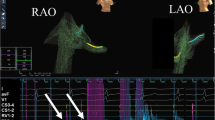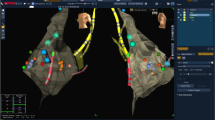Abstract
Purpose
To investigate the learning curve for atrial fibrillation (AF), supraventricular tachycardia (SVT), and premature ventricular contraction (PVC) radiofrequency ablation (RFA) using zero fluoroscopy.
Methods
This is a retrospective, single-center study of 167 patients undergoing ablation between 2016 and 2019. Minimal fluoroscopy approach was initiated after the first 20 cases of PVI and SVT RFA. Procedures were divided consecutively into increments of 10 cases to determine operator learning curve.
Results
A total of 64 (38%) had SVT ablations, 26 (16%) had PVC ablations, and 77 (46%) had AF and underwent PVI. For SVT RFA, fluoroscopy time improved from 4.1 ± 3.5 min during the first 10 cases to 0.8 ± 1.2 min after 50 cases (p = 0.0001). Sixty-two out of 64 (97%) of cases were successful. In PVC RFA, fluoroscopy time was 7.7 ± 5.5 min for the first 5, 2.3 ± 3.4 min after 15, and 0 min after 20 cases (p = 0.0008). Twenty-four out of 26 (92%) of cases were acutely successful with recurrence in 2/26 (8%) of patients over 9 ± 9 months. In PVI, fluoroscopy time was 9.9 ± 3.3 min over the first 20 cases, 2.6 ± 2.3 min after 40 cases, and 0.1 min after 50 cases (p < 0.0001). PVI procedure time was 170 ± 34 min after 60 cases from 235 ± 41 min initially (p 0.001). Six out of 77 (8%) had AF recurrence at 12 months.
Conclusions
Zero fluoroscopy ablation for AF, SVT, and PVC can be safely achieved without increasing procedure time. The steepest learning curve occurs over the first 20, 15, and 40 cases for SVT, PVC, and PVI ablation respectively.




Similar content being viewed by others
References
Chambers CE. Occupational health hazards in interventional cardiology: expected inherent risk or preventable personal liability? JACC Cardiovasc Interv. 2015;8:628–30.
Klein LW, Tra Y, Garratt KN, Powell W, Lopez-Cruz G, Chambers C, et al. Occupational health hazards of interventional cardiologists in the current decade: results of the 2014 SCAI membership survey. Catheter Cardiovasc Interv. 2015 Nov;86(5):913–24.
Buchanan GL, Chieffo A, Mehilli J, Mikhail GW, Mauri F, Presbitero P, et al. The occupational effects of interventional cardiology: results from the WIN for safety survey. Eurointervention. 2012;8(6):658–63.
Yang L, Sun G, Chen X, Chen G, Yang S, Guo P, et al. Meta-analysis of zero or near-zero fluoroscopy use during ablation of cardiac arrhythmias. Am J Cardiol. 2016;118(10):1511–8.
Razminia M, Willoughby MC, Demo H, Keshmiri H, Wang T, D’Silva OJ, et al. Fluoroless catheter ablation of cardiac arrhythmias: a 5 year experience. Pacing Clin Electrophyiol. 2017;40(4):425–33.
Lerman BB, Markowitz SM, Liu CF, Thomas G, Ip JE, Cheung JW. Fluoroless catheter ablation of atrial fibrillation. Heart Rhythm. 2017;14(6):928–34.
Bayanker T, Quadros KK, Thosani A, Yasmeh B, Mitra R, Liu E, et al. Safety and efficacy of zero fluoroscopy transseptal puncture with different approaches. Pacing Clin Electrophyiol. 2019;17.
Sommer P, Bertagnoli L, Kircher S, Arya A, Bollmann A, Richter S, et al. Safety profile of near-zero fluoroscopy atrial fibrillation ablation with non-fluoroscopic catheter visualization: experience from 1000 consecutive procedures. Europace. 2018;20(12):1952–8.
Santoro A, Di Clemente F, Baiocchi C, Zaca V, Bianchia C, Bellini C, et al. From near-zero to zero fluoroscopy catheter ablation procedures. J Cardiovasc Electrophysiol. 2019;30(11):2397–404.
Zei P, Hunter TD, Gache LM, O’Riordan G, Baykaner T, Brodt CR. Low-fluoroscopy atrial fibrillation ablation with contact force and ultrasound technologies: a learning curve. Pragmat Obs Res. 2019;10:1–7.
Gist K, Tigges C, Smith G, Clark J. Learning curve for zero-fluoroscopy catheter ablation of AVNRT: early versus late experience. Pacing Clin Electropysiol. 2011;34(3):264–8.
Giaccardi M, Del Rosso A, Guarnaccia V, Ballo P, Mascia G, Chiodi L, et al. Near-zero x-ray in arrhythmia ablation using a 3-dimensional electroanatomic mapping system: a multicenter experience. Heart Rhythm. 2016;13(1):150–6.
Author information
Authors and Affiliations
Corresponding author
Ethics declarations
This study was approved by the Cleveland Clinic institutional review board.
Conflict of interest
Drs. Wazni and Chung both serve as consultants to Biosense Webster Inc. The remaining authors have no conflict of interest.
Additional information
Publisher’s note
Springer Nature remains neutral with regard to jurisdictional claims in published maps and institutional affiliations.
Rights and permissions
About this article
Cite this article
Kochar, A., Ahmed, T., Donnellan, E. et al. Operator learning curve and clinical outcomes of zero fluoroscopy catheter ablation of atrial fibrillation, supraventricular tachycardia, and ventricular arrhythmias. J Interv Card Electrophysiol 61, 165–170 (2021). https://doi.org/10.1007/s10840-020-00798-8
Received:
Accepted:
Published:
Issue Date:
DOI: https://doi.org/10.1007/s10840-020-00798-8




